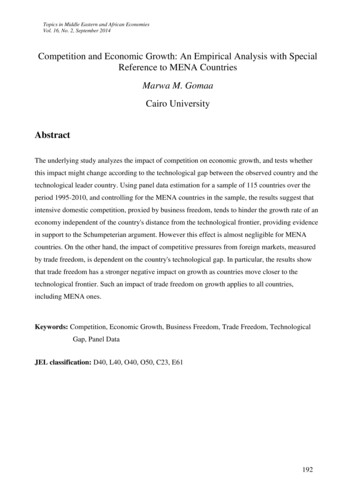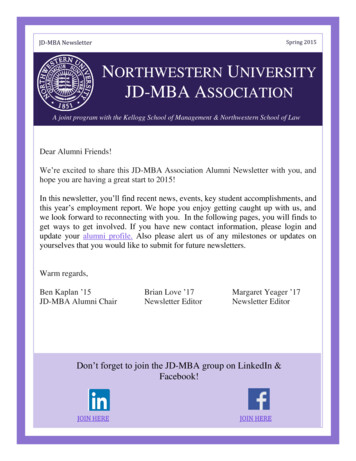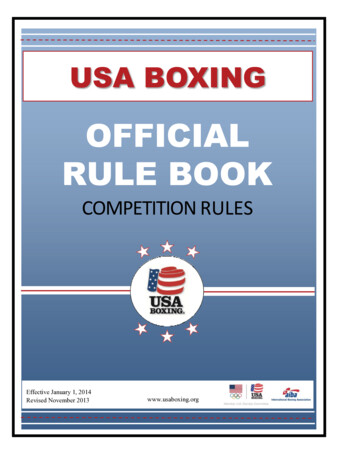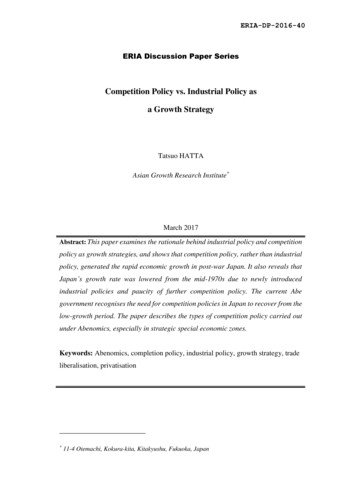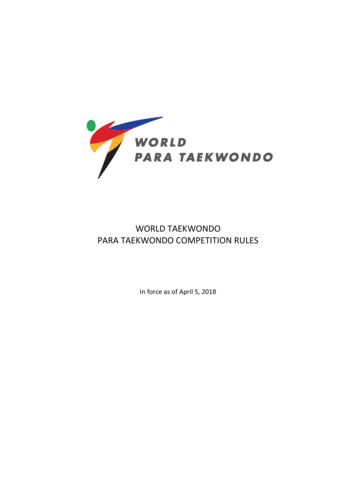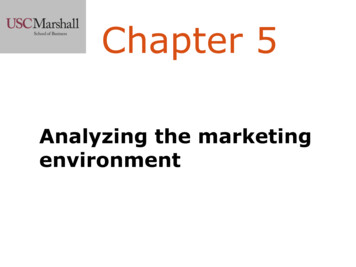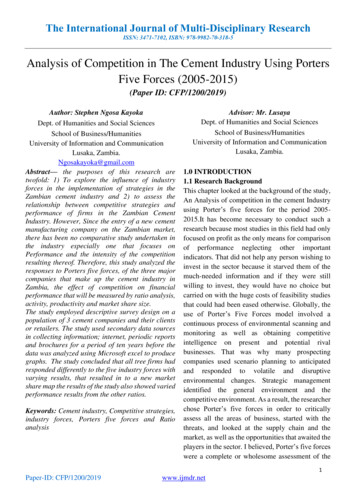
Transcription
The International Journal of Multi-Disciplinary ResearchISSN: 3471-7102, ISBN: 978-9982-70-318-5Analysis of Competition in The Cement Industry Using PortersFive Forces (2005-2015)(Paper ID: CFP/1200/2019)Author: Stephen Ngosa KayokaDept. of Humanities and Social SciencesSchool of Business/HumanitiesUniversity of Information and CommunicationLusaka, Zambia.Ngosakayoka@gmail.comAbstract— the purposes of this research aretwofold: 1) To explore the influence of industryforces in the implementation of strategies in theZambian cement industry and 2) to assess therelationship between competitive strategies andperformance of firms in the Zambian CementIndustry. However, Since the entry of a new cementmanufacturing company on the Zambian market,there has been no comparative study undertaken inthe industry especially one that focuses onPerformance and the intensity of the competitionresulting thereof. Therefore, this study analyzed theresponses to Porters five forces, of the three majorcompanies that make up the cement industry inZambia, the effect of competition on financialperformance that will be measured by ratio analysis,activity, productivity and market share size.The study employed descriptive survey design on apopulation of 3 cement companies and their clientsor retailers. The study used secondary data sourcesin collecting information; internet, periodic reportsand brochures for a period of ten years before thedata was analyzed using Microsoft excel to producegraphs. The study concluded that all tree firms hadresponded differently to the five industry forces withvarying results, that resulted in to a new marketshare map the results of the study also showed variedperformance results from the other ratios.Keywords: Cement industry, Competitive strategies,industry forces, Porters five forces and RatioanalysisAdvisor: Mr. LusayaDept. of Humanities and Social SciencesSchool of Business/HumanitiesUniversity of Information and CommunicationLusaka, Zambia.1.0 INTRODUCTION1.1 Research BackgroundThis chapter looked at the background of the study,An Analysis of competition in the cement Industryusing Porter’s five forces for the period 20052015.It has become necessary to conduct such aresearch because most studies in this field had onlyfocused on profit as the only means for comparisonof performance neglecting other importantindicators. That did not help any person wishing toinvest in the sector because it starved them of themuch-needed information and if they were stillwilling to invest, they would have no choice butcarried on with the huge costs of feasibility studiesthat could had been eased otherwise. Globally, theuse of Porter’s Five Forces model involved acontinuous process of environmental scanning andmonitoring as well as obtaining competitiveintelligence on present and potential rivalbusinesses. That was why many prospectingcompanies used scenario planning to anticipatedand responded to volatile and disruptiveenvironmental changes. Strategic managementidentified the general environment and thecompetitive environment. As a result, the researcherchose Porter’s five forces in order to criticallyassess all the areas of business, started with thethreats, and looked at the supply chain and themarket, as well as the opportunities that awaited theplayers in the sector. I believed, Porter’s five forceswere a complete or wholesome assessment of the1Paper-ID: CFP/1200/2019www.ijmdr.net
The International Journal of Multi-Disciplinary ResearchISSN: 3471-7102, ISBN: 978-9982-70-318-5market for whatever reason one may wanted tobring forth, be it investment, or merely justKnowledge. In this research, the researcher statedthe problem at hand and laid out the objectives ofthe study that would sharpen the direction of theresearch.1.2Background of the studyThe cement industry played a major role in meetingany country’s needs for housing and infrastructure.Cement, the glue that holds concrete together, is akey ingredient of economic development. Concretebecomes our offices, factories, homes, schools,hospitals and roads, as well as our undergroundwater and drainage pipes, bricks and blocks, and themortar that bonds them together. None of thosethings could be built without cement. There iscurrently no other material that could replace cementor concrete in terms of effectiveness, price andperformance for most purposes. In view of these, andthe fact that the construction industry in Zambia hadfor 4 consecutive years surpassed the miningindustry in terms of growth, grown at an average rateof 15% (Zambia Development Agency BulletinNo.2, 2015), there had been massive investments inthe cement industry in Zambia that had seen threenew factories being built in the last 5years bringingthe total number to 6. The Zambian cement industryand all the other manufacturing industries werecharacterized by change and volatility, yetbusinesses needed to make investment decisions thatequipped them to serve consumers and maintainprofitability through attaining and sustainingcompetitive advantage. A firm is said to have acompetitive advantage when it is implementing avalue creating strategy not simultaneously beingimplementing by any current or potentialcompetitors (Barney, 1991). One thing that iscertain, consumer values, needs and behaviours willcontinue to evolve.With the change of regime in 1991 from a oneparty state to a multi-party state, the Zambiangovernment embarked on a path to liberalize itseconomy. In 1992, the government implementedpolicies and enacted laws that would provide for afree market economy, as opposed to the pre – 1991controlled establishment of the previous regimekilled the various state monopolies and brought inother companies that competed for market share.Undeniably, a free market economy brought aboutcompetition and competition is a process ofeconomic rivalry between market players to attractconsumers. The market players could , selling both goods and services. Sucha competitive situation could also be affected bymarket contestability, where competition not onlycame from existing players, but also from newplayers that could enter and contest the market orfrom new products that could be introduced inexisting markets (CCPC, 2012). Most companiesadopted a more dynamic strategy related to theexisting resources in order to defend themselvesagainst industry structures and increased theirmarket share and performance. Before creativebusiness strategies, however, environment factorscame into consideration of establishing strategies.One sector that had seen a very high level ofcompetition in Zambia is the cement manufacturingsector.1.3 Porter’s five forcesIn order to more deeply understand and explain theZambian cement industry structure and all that hadbeen going on in this sector in the last 10 years (2005-2015), and how that had affected firm performance,I turned to the well-known Five Forces Modeldeveloped by Michael Porter. This study, therefore,aimed to apply Porter’s five forces in the analysis ofthe Cement Industry. It would seek to identify thecompetitive strategies implemented by firms andhow the application of those strategies affectedperformance and also explained the issues in thesector as stated above.2Paper-ID: CFP/1200/2019www.ijmdr.net
The International Journal of Multi-Disciplinary ResearchISSN: 3471-7102, ISBN: 978-9982-70-318-51.4 Statement of the ProblemThe Zambia Cement Industry had seen a rapidincrease in competition. The challenges ofcompetition were both global and local. The 2014financial records for the leading firm, listed on theLusaka Stock Exchange showed that the companyenjoyed a 27% increase in earnings before interestand tax EBIT to ZMK 687m and a 25% increase inProfits after tax to ZMW 424m from the previousfinancial year. The entry, on the market, of a newplayer with larger capacity threated to erode theprofitability of the current players in the market. Thetransition from monopoly to oligopoly had exerted alot of pressure on the cement companies; to surviveand sustain their profitability; those companies hadto embark on strategies that might have given themcompetitive advantage. The firms had to seek newways of acquiring, retaining and increasing business.A free market economy is based on supply anddemand factors and the government had little or nointervention. In a free market economy, competitionis the force that ensures that only those enterprisesthat responded to market dynamics were able tocapture market share and ultimately survive.Therefore, the researcher would assess the generalresponse of all the firms to the growing competitionin the Zambian cement industry – assessing how theindustry forces impacted on profitability and growthwhile at the same time assess how the strategicresponded according to Porter’s theory, had beenused in order to continue in business. Consideringthe issues that had been happening in the cementmanufacturing sector as stated above, the collusionallegations, the power deficits, the allegedunlevelled capital playing field occasioned by someform of backward integration by one major player, itthen became imperative to understand all those froman economic point of view and as the research wouldhad it, from Porter’s five forces.1.5Research PurposeThe purposes of this research were twofold:(1) Toexplore the influence of industry forces in theimplementation of strategies in the Zambian cementindustry and (2) to assess the relationship betweencompetitive strategies and performance of firms inthe Zambian Cement Industry.1.6 Research QuestionsThe following research questions guided thisresearch.1. What level of influence did the threat of newentrants had on performance of Cement industryin Zambia?2. What extent of bargaining power did suppliershad relative to performance of Cement industryin Zambia?3. What was the influence of substitute products onperformance of Cement industry in Zambia?4. What extent of bargaining power did buyers hadrelative to performance of Cement industry inZambia?5. What was the effect of rivalry between firms onperformance of Cement industry in Zambia?6. What had been the business and financialPerformance of the Cement industry in the (FY2005 – FY2015) considering its profitability,liquidity, asset management, financial leverageand equity analysis?1.7 HypothesesHypotheses predict relationships between variables.According to Creswell (2005) they can becategorized into the null hypotheses and alternativehypotheses. The null hypothesis predicts that norelationship exists between variables, and thealternative hypothesis is a true statement if theresults of statistical analyses are used to reject thenull hypothesis.Based on the research questions, the following nullhypotheses guided this study:3Paper-ID: CFP/1200/2019www.ijmdr.net
The International Journal of Multi-Disciplinary ResearchISSN: 3471-7102, ISBN: 978-9982-70-318-5H01: Threat of new entrants did not have significantinfluence on performance of Cement industry inZambia.H02: Bargaining power of supplier did not affectperformance of Cement industry in Zambia.H03: Substitute products did not have significantinfluence on performance of Cement industry inZambia.H04: Bargaining power of buyers did not affectperformance of Cement industry in Zambia.H05: Rivalry between firms did not have significanteffects on performance of Cement industry inZambia.1.8 Scope of the StudyThe Cement industry in Zambia is complex anddiversified, consisting of firms from themultinational to many small local firms. In thisregard, the study would focus the four cementproducing companies in Zambia Vis; LafargeHoldings, Zambezi Portland Cement and Dangoteand would limit itself to the Lusaka and theCopperbelt as the major markets for formalizedcement industry. Due to lack of sufficient sectorspecific basic literature in the cement industry inZambia, it was hard to determine the level ofcompetitiveness. The study would thus, throughliterature review, analyze the competition byadapting the dimensions of Porters five forces. Thedimensions of competition were, the analysis of newentrants in the business, the bargaining power ofsuppliers, the threat of product substitutes, thebargaining power of buyers and the competitiverivalry within the industry itself.1.9 Significance of the StudyEven though the study did not seek to build theoryon competition, the findings would be useful tocement industries as a basis for the formulation ofcompetitive strategies in order to ensure continuedsurvival and profitability. The results would alsoprovide information to the regulators of any anticompetitive practices.1.10Definition of termsAccording to Porter (1983) the definitions for thekey terms are given below Cost leadership strategy:that focuses on pushing its costs down. This strategycalled "the low-cost strategy". Differentiatingstrategy: is a strategy of lunching differentiatedproducts which the company provides to itscustomers distinctive features products that satisfiestheir needs as the have a willingness to pay more forthese products. Focus strategy: It is a strategy offocusing on a particular segment in the market. Thiswill be achieved through introducing products thatare suitable for a particular group of customers andsatisfies their needs.1.11 Review of Porter’s Five Forces ModelIn that seminal work on strategic management,Michael E. Porter (1980, 1985) provided a powerfulinstrument for thoroughly analyzing environmentalforces and market structures in an industry. Porter’sfive forces model provided a flexible framework fordescribing and assessing competitive pressures in anindustry and industry attractiveness. Based on thisanalysis, a company could develop a competitivestrategy for gaining and sustaining competitiveadvantages over rival firms and thereby generatingabove-average return on investments.According to Porter (1985), the five factors that acttogether to determine the nature of competitionwithin an industry were; Competitive Rivalry,Threat of Entry, Threat of Substitutes, BargainingPower of Buyers and bargaining Power of Suppliers(Porter, 1985). The intensity of these forcesdetermines the average expected level ofprofitability (McGanan, 1997). The industry forcesapproach assumed that firms within an industrypossessed identical or similar resources. As a result,a firm’s success depended on how to react to marketsignals and accurately predicted the evolution of theindustry structure (Kim & Oh, 2004).4Paper-ID: CFP/1200/2019www.ijmdr.net
The International Journal of Multi-Disciplinary ResearchISSN: 3471-7102, ISBN: 978-9982-70-318-52.1 THEORETICAL REVIEW2.1 Bargaining power of suppliersAccording to Porter (1980), power of suppliersrefers to the ability of suppliers to influence cost,availability and quality of input materials to firmswithin the industry. The strength of the suppliermainly depends on what they have to offer to thepurchaser (Porter, 1998). Mistikoglu & Oral (2005)show that “according to Porter’s five forces model,suppliers have control over competition in theindustry through their bargaining power”. Lynch(2006) argues that suppliers are absolutely necessaryfor every organization that supports theOrganization’s final production by raw materials orservices. According to Porter (1985), suppliers maybe powerful under the following conditions: There are very few suppliers of a particularproduct There are no substitutes Switching to another (competitive) product isvery costly The product is extremely important to the buyer,they cannot do without it The supplying industry has a higher profitabilitythan the buying industry2.2Bargaining power of buyersWheelen & Hunger (2008) argue that "buyers affectan industry through their ability to force downprices, bargain for higher quality or more services,and play competitors against each other". Thebargaining power of customers determines howmuch customers can impose pressure on volumesand margins. The power of each of the industry’sbuyer groups depends on the characteristics of itsmarket situation and on the relative importance of itspurchases from the industry compared with itsoverall business (McCray, 1985 cited in de Villiers,2012). According to Porter (1980; 2000) both buyersare powerful under the following conditions:They are concentrated and buy in large volumes.The buyer's purchases are a sizable percentage of theselling industry's total sales.The supplying industry is comprised of largenumbers of relatively small sellers.The item being purchased is sufficientlystandardized among sellers that not only can buyersfind alternative sellers but also, they can switchsuppliers at virtually zero cost.The buyers pose a threat of integrating backward tomake the industry's product.The sellers pose little threat of forward integrationinto the product market of buyers.The products are unimportant to the quality of thecustomer's product or service.It is economically feasible for buyers to follow thepractice of purchasing the input from severalsuppliers rather that one.2.3 Threat of Substitute Products Substitutesrefer to products and services from another industrythat can satisfy the same needs as products of thefocal industry. Microeconomics teaches that themore substitutes a product has, the more the demandfor the product becomes more elastic. Elasticdemand means increased consumer price sensitivitywhich equates to less certainty of profits.Conditions that increase the threat of substitutes are:An attractive price of substitutes: The price ofsubstitutes acts as a ceiling to the price of the subjectproduct. An attractive price of a substitute inhibits anindustry from reaching its profit potential. Increasedquality of substitutes: If the quality of a substitute ishigh, there is increased pressure to increase thequality of the subject product.Low switching costs to consumers: Switching coststo consumers can come in the form of monetarycosts. Monetary costs effectively increase the priceof the substitute products whereas lifestyle costs aremore subjective and difficult to identify. In any case,the easier and less costly it is to switch to a substitute,the higher the threat of that substitute.5Paper-ID: CFP/1200/2019www.ijmdr.net
The International Journal of Multi-Disciplinary ResearchISSN: 3471-7102, ISBN: 978-9982-70-318-52.4 The threat of new entrants2.6 Theories of Competitive AdvantageA major force shaping competition within anindustry is the threat of new entrants. The threat ofnew entrants is a function of both barriers to entryand the reaction from existing competitors. Threat ofNew Entrants - The easier it is for new companies toenter the industry, the more cutthroat competitionthere will be.The theory of competitive advantage suggests thatthe only important concept at national level e advantage rests on the notion that laboris ubiquitous and natural resources are not necessaryfor a good economy (Mugwe, 2012). The MarketBased View (MBV) of strategy argues that industryfactors and external market orientation are theprimary determinants of firm performance (Bain1968). Opposed to the MBV is the Resource-BasedView (RBV) that argues that the firm’s internalenvironment is the driver for competitive advantage.Economies of scale. Economies of scale act asbarrier to entry by requiring the entrant to come onlarge scale, risking strong reaction from existingcompetitors, or alternatively to come in on a smallscale accepting a cost disadvantage Productdifferentiation creates a barrier to entry by forcingentrants to incur expenditure to overcome existingcustomer loyalties. The capital costs of gettingestablished in an industry can be so large as todiscourage all but the largest companies. Costadvantages independent of scale. Switching costsrefer to the one-time costs that buyers of theindustry's outputs incur if they switch from onecompany's products to another's. To overcome theswitching cost barrier, new entrants may have tooffer buyers a bigger price cut or extra quality orservice. A new entrant may have to persuade thedistribution channels to accept its product byproviding extra incentives which reduce profits.Governmental and legal barriers. Governmentagencies can limit or even bar entry by requiringlicenses and permits. National governmentscommonly use tariffs and trade restrictions(antidumping rules, local content requirements, andquotas) to raise entry barriers for foreign firms.2.5 Competitive RivalryThompson & Strickland (1996) argue that "thestrongest of the five competitive forces is usually thejockeying for position and buyer favor that goes onamong rival firms. Competitive Rivalry describesthe intensity of competition between existing firmsin an industry.2.7 Competitive AdvantageLynch (1999) describes competitive advantage asthe ability gained through attributes and resources toperform at a higher level than others in the sameindustry. According to Jones (2007:12), competitiveadvantage is “the ability of one company tooutperform another because its managers are able tocreate more value from the resources at theirproposal.” The Concept of competitive advantagewas formulated by Michael Porter (1985).2.8. Cost Leadership StrategyUnder Cost Leadership, a firm sets out to be the lowcost producer in its industry. The organization aimsto drive costs down for all production elements fromthe sourcing of materials, to labor costs. To achievecost leadership a business will usually need largescale production so that they can benefit from"economies of scale". Firms that succeed in costleadership often have the following internalstrengths: Access to the capital required making asignificant investment in production assets; thisinvestment represents a barrier to entry that manyfirms may not overcome.2.9 Differentiation StrategyAccording to Porter (1985), in a differentiationstrategy, a firm seeks to be unique in its industry6Paper-ID: CFP/1200/2019www.ijmdr.net
The International Journal of Multi-Disciplinary ResearchISSN: 3471-7102, ISBN: 978-9982-70-318-5along some dimensions that are widely valued bybuyers. With a differentiation strategy the businessdevelops product or service features which aredifferent from competitors and appeal to customersincluding functionality, customer support andproduct quality.2.10 Focus (Niche) StrategyA focus strategy concentrates on a narrow segmentand attempts to achieve either a cost advantage ordifferentiation within that segment. Porter arguedthat competitive advantage through a focus strategyis gained either by cost-leadership in that segment,or, differentiation by meeting the needs of the targetsegment more effectively2.11 Stuck in the MiddlePorter argued that a firm must make a consciouschoice about the competitive advantage it seeks todevelop. If a firm engages in each generic segmentbut fails to achieve in any of them it is ‘stuck in themiddle’. For Porter, "being all things to all people'is a recipe for strategic mediocrity and belowaverage performance" (1985, p. 12).2.12 Other Strategies for Key AdvantagesAlliancesCompetitive advantages can also be gained bybusinesses that seek strategic alliances with otherbusinesses in related industries or within the sameindustry.CHAPTER THREETHEORETICAL AND CONCEPTUALFRAMEWORK3.0 IntroductionFrom the previous review of literature and thevariables proposed, the conceptual framework wasestablished as explained in figure 4.1 below. Intheory, when firms had the advantage over theindustry forces, those advantages could indicate thecompetency in brand image, human resource, and ITstrategies. As a result, those competitive resourcestrategies would increase performance behaviorallyand financially.3.1 Theoretical FrameworkVarious theories and perspectives have beenadvanced that attempt to explain competitiveadvantage. Gaining and sustaining competitiveadvantage was the overarching objective of firms’strategy. One of the big cornerstones of industry andcompetitive analysis involved carefully studying theindustry's competitive process to discover the mainsources of competitive pressure and how strong theyare (Ohmae, 1983). Alam, Azim and Islam (2010)explain that the first fundamental determinant of afirm’s profitability is industry attractiveness. In hisseminal work on Strategic Management, Porter(1980, 1985) provides a powerful instrument forthoroughly analysing environmental forces andmarket structures in an industry. Porter’s Five Forcesmodel provides a flexible framework for describingand assessing competitive pressures in an industryand industry attractiveness and thus will be used as atool in assessing the two dimensions by applicationin the Zambian Market, which has seen fiercecompetition and a price war. Porter’s Five ForcesFramework is one of the strategic models used toassess the attractiveness of the industry (be it serviceor manufacturing). This model is defined by the fivekey forces which are; Rivalry among the existingfirms, Threat of new entrants, Threat of substitutes,bargaining power of suppliers and bargaining powerof customers. Based on this analysis, a company can7Paper-ID: CFP/1200/2019www.ijmdr.net
The International Journal of Multi-Disciplinary ResearchISSN: 3471-7102, ISBN: 978-9982-70-318-5develop a competitive strategy for gaining andsustaining competitive advantages over rival firmsand thereby generating above average return oninvestment (Porter, 1980). Porter (1980) contendsthat every firm competing in an industry has astrategy. In order to survive, firms have to makechoices: selection of goals, choice of products and/orservices to offer, the design and configuration ofpolicies determining how the firm positions itself tocompete in product markets – competitive strategy,choice of an appropriate level of scope and diversity;and the design of organization structure,administrative systems and policies used to defineand coordinate work.3.2 Conceptual frameworkIn figure 3.1, this researcher conceptualized thatindustry attractiveness is a fundamental determinantof competitive advantage. A firm’s profitability isinfluenced by its relative size compared to itsindustry rivals, suppliers and customers (Porter,1985). Consequently, the industry forces in which afirm operates requires that the firm adapts to theserequirements in order to survive in the long run.Firms should seek to screen against and exploit thecompetitive forces in order to obtain and keep highprofitability (Porter, 1980). Firms create competitiveadvantage/Performance by discovering new andbetter ways to compete in an industry. Thedependent variable in this study was competitiveadvantage while the independent variables werebarriers to entry, intensity of rivalry, bargainingpower of buyers, bargaining power of suppliers,substitute products and government policies. Thisindependent variable was studied and researchpresented on the degree to which it affectedperformance/competitive advantage.Figure 3.1 Conceptual FrameworkEntryBarriersBuyer PowerFirm PerformancePerformanceSupplierPowerThreat ofSubstitutesRivalryDependent VariablesFirm PerformanceIndependent VariablesIndustry forcesSource: Porter’s (1980)8Paper-ID: CFP/1200/2019www.ijmdr.net
The International Journal of Multi-Disciplinary ResearchISSN: 3471-7102, ISBN: 978-9982-70-318-5Competitive advantage grows out of the way firmsperform discrete activities – conceiving new waysto conduct activities, employing new procedures,new technologies, or different inputs. To achieveand sustain CA, firms must compete effectively tooutperform their competitors in this dynamicenvironment, this can be achieved by identifyingappropriate ways of creating and adding value fortheir customers as competition exerts pressure onfirms to be proactive and to formulate successfulstrategies that facilitate proactive responses toforeseen and actual changes in the environment(Ngetich, 2010).3.3 Analysis of DataTo analyze data collected from the employeesthrough the questionnaire, the statistical packagefor social scientists was used to regress the fiveforces against performance. A comparativeanalysis was then made using porters five forcestheory in order to assess the intensity of thecompetition. The results are then shown usingtables and graphs generated by excel. The findingsare presented thematically in graphs and charts.Further, secondary data collected supports thefindings. The model that guided the study was:y β0 βixi ε Where y dependent variableβ0 Constant i 1, 2,3,4,5 are the researchobjectives (each of Porters five forces). HencePerformance β0 β1 (objective) ε the output ofeach objective accepted or rejected the nullhypothesis. To test the hypotheses; H01: Threat ofnew entrants does not have significant influenceon performance of Cement industry in Zambia.CHAPTER FOURDATA PRESENTATION ANDANALYSIS4.0 IntroductionThe chapter provides the findings in graphicalform and then provides analysis of the samegraphical results.4.1 Demography4.1.1 Gender and Age of RespondentsOf the 66 respondents who participated in thestudy, 94% (62) were male, and 6% (4) werefemale. This shows a great disparity on genderportraying cement in Zambia as a maledominated field as shown in figure 4.1Female6%Sex of RespondentsMale94%Source: Researcher’s computation using excelIn terms of age, majority of the respondents 36.4%(24) were aged 33-37 years, followed by those aged28-32 years at 27.3% (18), 38 years and above at24.2% (16) and 23-27 years as the least age bracketat 12.1% (8). This shows more than half (63.7%) ofthose in management positions were above 28 yearsold while 36.3% were below 28 years old. Based onthis, the older one becomes, the more likely heascends to management position.The comparison of age based on gender shows 75%(3) of the females were 23-27 years while theremaining 25% (1) were 28-32 years. For malerespondents, those aged 33-37 years were 38.7%(24) of the respondents followed by 28-32 years
Paper-ID: CFP/1200/2019 www.ijmdr.net market for whatever reason one may wanted to bring forth, be it investment, or merely just Knowledge. In this research, the researcher stated the problem at hand and lai






